Sommaire
How did the Disneyland Paris crowd panic spread across digital spaces?
For years, I have been fascinated by the spread of crowd movements through digital spaces. In fact, in the category of messages coming from social media during emergencies, they are a significant issue in training emergency personnel, as these situations often leave the emergency manager with limited information, forcing them to pay close attention to available signals, which could affect their perception.
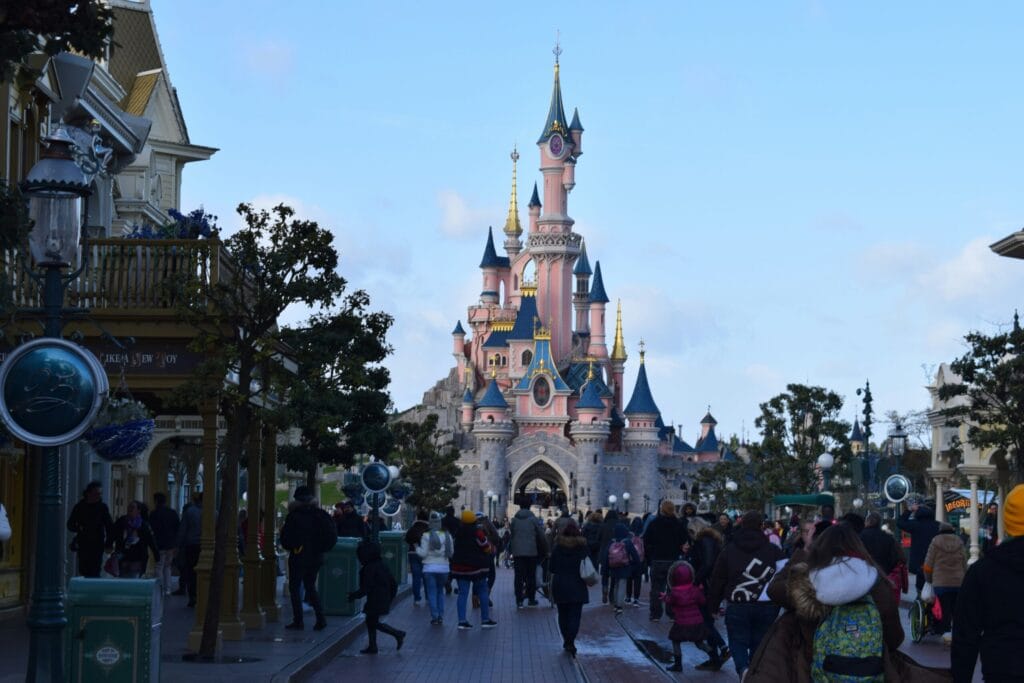
Last night, as the first reports started circulating, I tweeted, not to discourage the spreading of rumors, but to indicate that all the signals suggested we were dealing with a false alarm after reading different tweets for about two minutes.
Subsequent information proved me right and confirmed that the legal precedent in such matters is important to share. Hence, I couldn’t help but write an analysis article.
For this one, I used Visibrain.
Key insights
Confirmation of a recurring pattern
There is indeed confirmation of many previously observed lessons:
On Twitter, there is always a kernel of truth at the start of a rumor. A firecracker, a crowd movement, a gathering of police officers, etc. This kernel of truth allows the rumor to be confirmed by people on the scene, who tell those not present that something is indeed happening. In this case, this was true as there were numerous testimonies and something was indeed happening.
The rumor is then spread by people who are not on the scene. Questions from absent individuals wondering what is going on, or "Twitter journalists." Twitter journalists are the main channels for misinformation about events. They quickly grab a video, are neither French nor on the scene, and only echo the fact that “something is happening.” These accounts are mainly retweeted by people close to the far-right and Trump supporters.
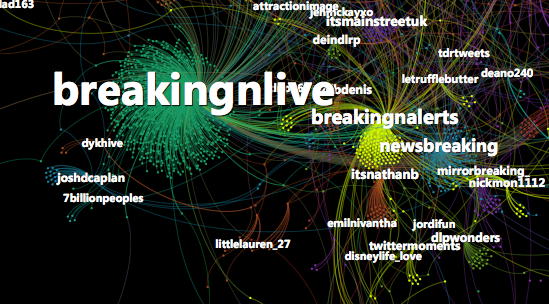
The rumor always undergoes a modification or distortion. A firecracker becomes an explosion, then a shooting. A gathering of riot police becomes a hostage situation, etc. Similarly, we heard reports of shootings, a bomb, a mad gunman, etc.
The rumor is confirmed by external elements (police on site, helicopters in the sky, store closures, etc.).
Once the rumor is debunked, it quickly dies down. In fact, it fades. But it takes 1 hour and 45 minutes if we count retweets and only 30 minutes for regular tweets. This demonstrates the logic of timelines and the community-driven nature of information. Simply being a media outlet or authority is not enough to quickly stop a rumor.

The peak was observed at 10:17 p.m., just a few minutes after the rumor was debunked. This allows for the global peak, after which the volume drops significantly.
I think we can also draw a redundant lesson.
For there to be a real crisis, there must be an evolution in the main scenario, such as reclassifying the explosion. In this case, no one is talking about the explosion anymore. There is mention of a man with a rifle, but no gunfire. People are talking about a crowd movement, the RAID police unit on site, and people in lockdown, but the crisis locations are not described and do not evolve.
The outcome
According to Twitter, there were 253 articles, 95 via Facebook. Thus, there was extensive media coverage, with 24-hour news channels (BFM, LCI), major newspapers (Le Monde), and even national coverage (Belgium, the Netherlands, USA, UK, etc.).
Disneyland Paris: MSGU (Social Media in Emergency Management) procedures need to be reviewed
I must admit: I was very surprised by Disneyland's communication. I won’t risk being incendiary, as I don’t know their internal challenges or the discussions that guided their decision-making, just as I almost always refrain from criticizing organizational communications. However, I must share my surprise that an organization whose operations were completely paralyzed, whose customers were in lockdown, and where rumors were rampant, did not take responsibility, did not show the level of leadership expected, and left its employees as the only hesitant spokespersons, even revealing the name of their "Omega Plan" operation without providing any explanation.
The only communication on Twitter was this: a promotion with fireworks emojis; nothing on the PR account; and, at most, a late retweet of the prefecture’s tweet. I can only express my disbelief.
And, in the world of risk we live in, with the heightened threat of terrorist attacks, I can only say that Disney should review its MSGU procedures to take control of the narrative when something happens, to prevent the media from writing speculative articles without citations, and to avoid letting numerous employees express themselves in private groups with conspiratorial undertones, as I have observed (“We are trained in anti-terrorist plans, and the Omega plan is not triggered for a simple escalator,” could be read here and there).
Timeline of events
The first tweet came from ProjetDLP, wondering what was happening at Disneyland Paris.

Already a sign of a lack of information, close contacts initiated a conversation, and the person asking questions could only relay physical statements.

Only a few reports emerged.
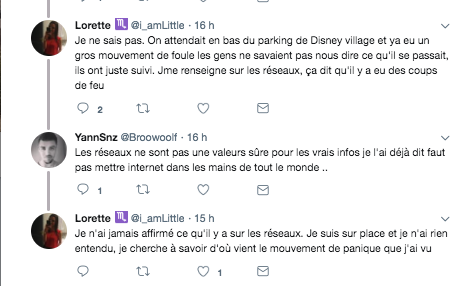
Then came the first interpretation of the noise as gunfire.

From someone who would say, "I’m just repeating what I’m being told, man." At that moment, the crowd movement began to spread over large areas inside the Disney Village.
The first mention of "terrorist attack" appeared.
The first image of the lockdown emerged, acting as confirmation of events for Twitter, which would accelerate thereafter.

However, it had already been more than 10 minutes since the signals were launched, indicating little evolution in the primary narrative, except for one tweet, now deleted.

These claims naturally led to more questions.
9:31 p.m. | The first counter-signals became available.

Then the first press article came from DH.Be, a Belgian daily newspaper.

Of course, given the international nature of the amusement park, there were international variations as well.
The first video then appeared, and La Libre Belgique reported a false alarm. This video was viewed 385,000 times.
More testimonies emerged.
The "Twitter journalist" accounts echoed the event:
https://twitter.com/BreakingNLive/status/1109557326887952386
Initial explanations began to surface, though they were only hypotheses:
https://twitter.com/kadi53521481/status/1109557095693721600
Meanwhile, Dutch-language tweets continued to report evacuations:
https://twitter.com/teamlooopings/status/1109556728146944000
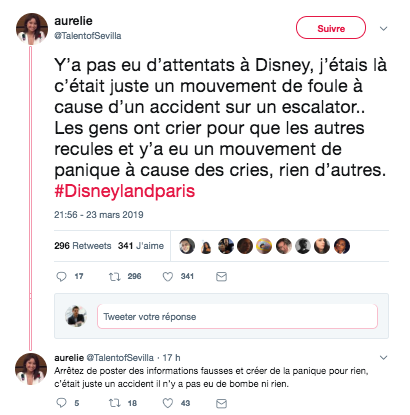
10:07 p.m. | The first confirmation with all the facts.

Followed by online news channels.
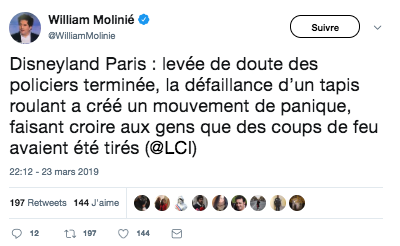
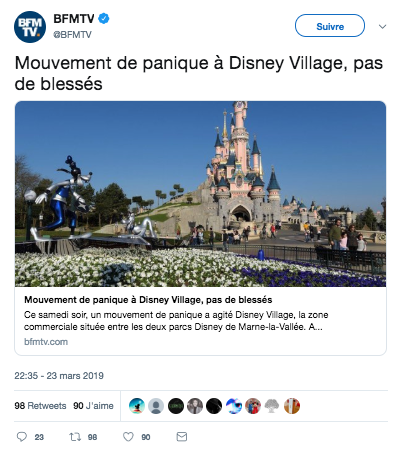
Finally, the prefecture ended the discussions, with Disney retweeting the information.
Full propagation
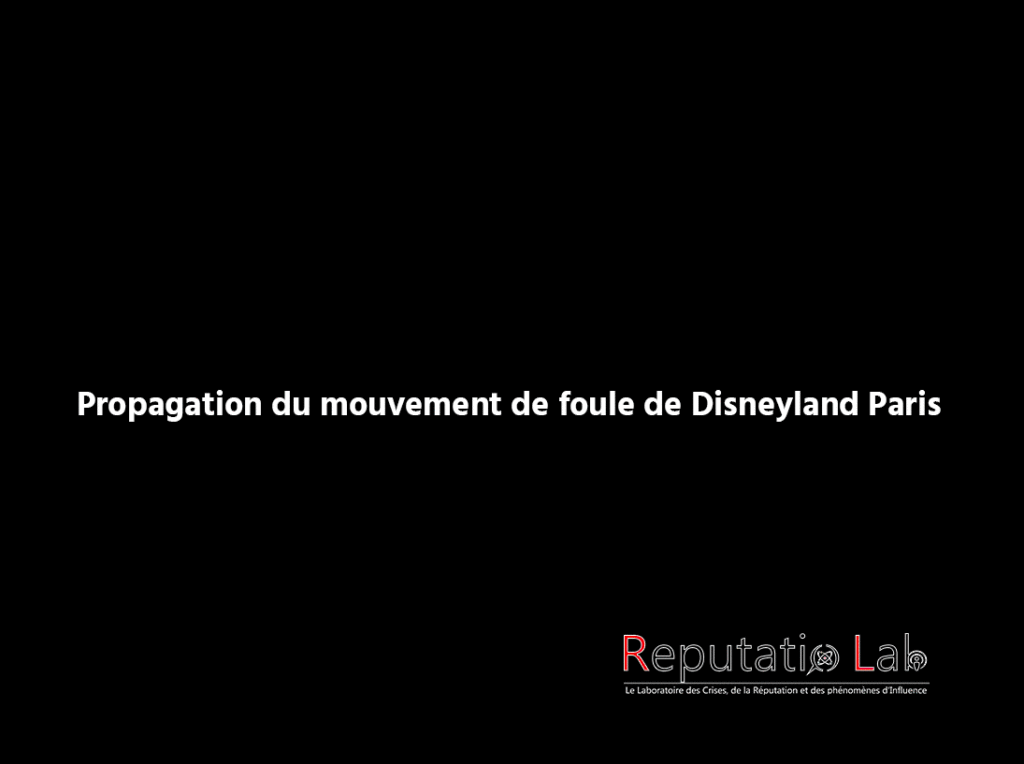
Some data

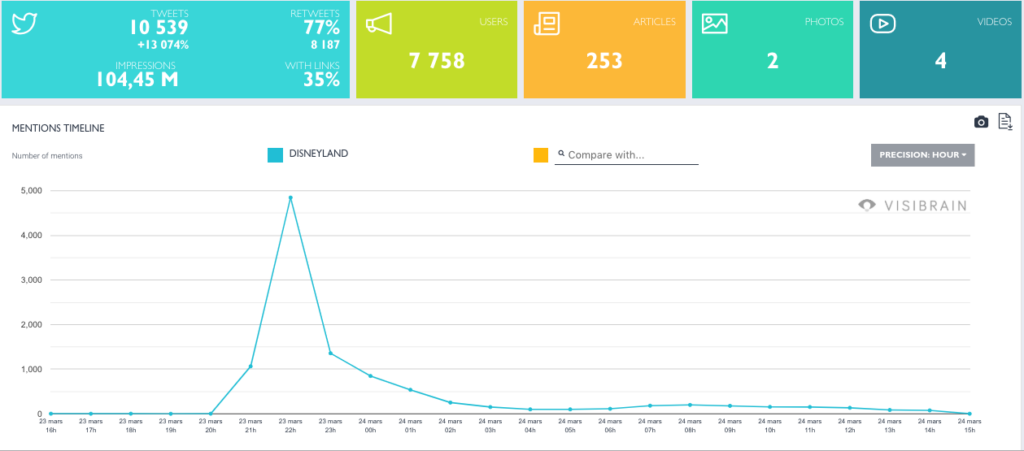
The peaks of mentions on Facebook and Twitter coincided, indicating that we were dealing with a primarily media-driven ecosystem.

The crisis was propagated globally.

Photo credit : Unsplash



